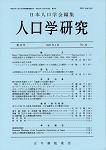Volume 21
Displaying 1-37 of 37 articles from this issue
- |<
- <
- 1
- >
- >|
Index
-
Article type: Cover
1997Volume 21 Pages Cover1-
Published: November 30, 1997
Released on J-STAGE: September 12, 2017
Download PDF (1251K) -
Article type: Index
1997Volume 21 Pages Toc1-
Published: November 30, 1997
Released on J-STAGE: September 12, 2017
Download PDF (1251K) -
Article type: Appendix
1997Volume 21 Pages App1-
Published: November 30, 1997
Released on J-STAGE: September 12, 2017
Download PDF (842K)
Presidential Address
-
Article type: Article
1997Volume 21 Pages 1-6
Published: November 30, 1997
Released on J-STAGE: September 12, 2017
Download PDF (888K)
Article
-
Article type: Article
1997Volume 21 Pages 7-17
Published: November 30, 1997
Released on J-STAGE: September 12, 2017
Download PDF (1780K)
Note
-
Article type: Article
1997Volume 21 Pages 19-25
Published: November 30, 1997
Released on J-STAGE: September 12, 2017
Download PDF (940K) -
Article type: Article
1997Volume 21 Pages 27-33
Published: November 30, 1997
Released on J-STAGE: September 12, 2017
Download PDF (1230K)
Scientific Information
-
Article type: Article
1997Volume 21 Pages 35-41
Published: November 30, 1997
Released on J-STAGE: September 12, 2017
Download PDF (1160K)
Reports
-
Article type: Article
1997Volume 21 Pages 43-46
Published: November 30, 1997
Released on J-STAGE: September 12, 2017
Download PDF (627K) -
Article type: Article
1997Volume 21 Pages 47-50
Published: November 30, 1997
Released on J-STAGE: September 12, 2017
Download PDF (769K) -
Article type: Article
1997Volume 21 Pages 51-54
Published: November 30, 1997
Released on J-STAGE: September 12, 2017
Download PDF (810K) -
Article type: Article
1997Volume 21 Pages 55-56
Published: November 30, 1997
Released on J-STAGE: September 12, 2017
Download PDF (349K) -
Article type: Article
1997Volume 21 Pages 57-60
Published: November 30, 1997
Released on J-STAGE: September 12, 2017
Download PDF (887K) -
Article type: Article
1997Volume 21 Pages 61-63
Published: November 30, 1997
Released on J-STAGE: September 12, 2017
Download PDF (382K) -
Article type: Article
1997Volume 21 Pages 64-67
Published: November 30, 1997
Released on J-STAGE: September 12, 2017
Download PDF (799K) -
Article type: Article
1997Volume 21 Pages 68-71
Published: November 30, 1997
Released on J-STAGE: September 12, 2017
Download PDF (509K) -
Article type: Article
1997Volume 21 Pages 72-75
Published: November 30, 1997
Released on J-STAGE: September 12, 2017
Download PDF (802K) -
Article type: Article
1997Volume 21 Pages 76-79
Published: November 30, 1997
Released on J-STAGE: September 12, 2017
Download PDF (559K)
Scientific Information
-
Article type: Article
1997Volume 21 Pages 80-83
Published: November 30, 1997
Released on J-STAGE: September 12, 2017
Download PDF (696K)
Book Reviews
-
Article type: Article
1997Volume 21 Pages 84-
Published: November 30, 1997
Released on J-STAGE: September 12, 2017
Download PDF (272K) -
Article type: Article
1997Volume 21 Pages 85-
Published: November 30, 1997
Released on J-STAGE: September 12, 2017
Download PDF (263K) -
Article type: Article
1997Volume 21 Pages 86-
Published: November 30, 1997
Released on J-STAGE: September 12, 2017
Download PDF (253K) -
Article type: Article
1997Volume 21 Pages 87-
Published: November 30, 1997
Released on J-STAGE: September 12, 2017
Download PDF (260K) -
Article type: Article
1997Volume 21 Pages 88-
Published: November 30, 1997
Released on J-STAGE: September 12, 2017
Download PDF (235K) -
Article type: Article
1997Volume 21 Pages 88-
Published: November 30, 1997
Released on J-STAGE: September 12, 2017
Download PDF (235K) -
Article type: Article
1997Volume 21 Pages 88-
Published: November 30, 1997
Released on J-STAGE: September 12, 2017
Download PDF (235K) -
Article type: Appendix
1997Volume 21 Pages 89-
Published: November 30, 1997
Released on J-STAGE: September 12, 2017
Download PDF (44K)
PAJ Information
-
Article type: Appendix
1997Volume 21 Pages 90-94
Published: November 30, 1997
Released on J-STAGE: September 12, 2017
Download PDF (716K) -
Article type: Appendix
1997Volume 21 Pages 95-98
Published: November 30, 1997
Released on J-STAGE: September 12, 2017
Download PDF (463K) -
Article type: Appendix
1997Volume 21 Pages 98-
Published: November 30, 1997
Released on J-STAGE: September 12, 2017
Download PDF (109K) -
Article type: Appendix
1997Volume 21 Pages 99-
Published: November 30, 1997
Released on J-STAGE: September 12, 2017
Download PDF (118K) -
Article type: Appendix
1997Volume 21 Pages 100-101
Published: November 30, 1997
Released on J-STAGE: September 12, 2017
Download PDF (192K) -
Article type: Appendix
1997Volume 21 Pages 102-
Published: November 30, 1997
Released on J-STAGE: September 12, 2017
Download PDF (71K) -
Article type: Appendix
1997Volume 21 Pages 102-
Published: November 30, 1997
Released on J-STAGE: September 12, 2017
Download PDF (71K) -
Article type: Appendix
1997Volume 21 Pages App2-
Published: November 30, 1997
Released on J-STAGE: September 12, 2017
Download PDF (842K) -
Article type: Cover
1997Volume 21 Pages Cover2-
Published: November 30, 1997
Released on J-STAGE: September 12, 2017
Download PDF (934K) -
Article type: Index
1997Volume 21 Pages Toc2-
Published: November 30, 1997
Released on J-STAGE: September 12, 2017
Download PDF (934K)
- |<
- <
- 1
- >
- >|
